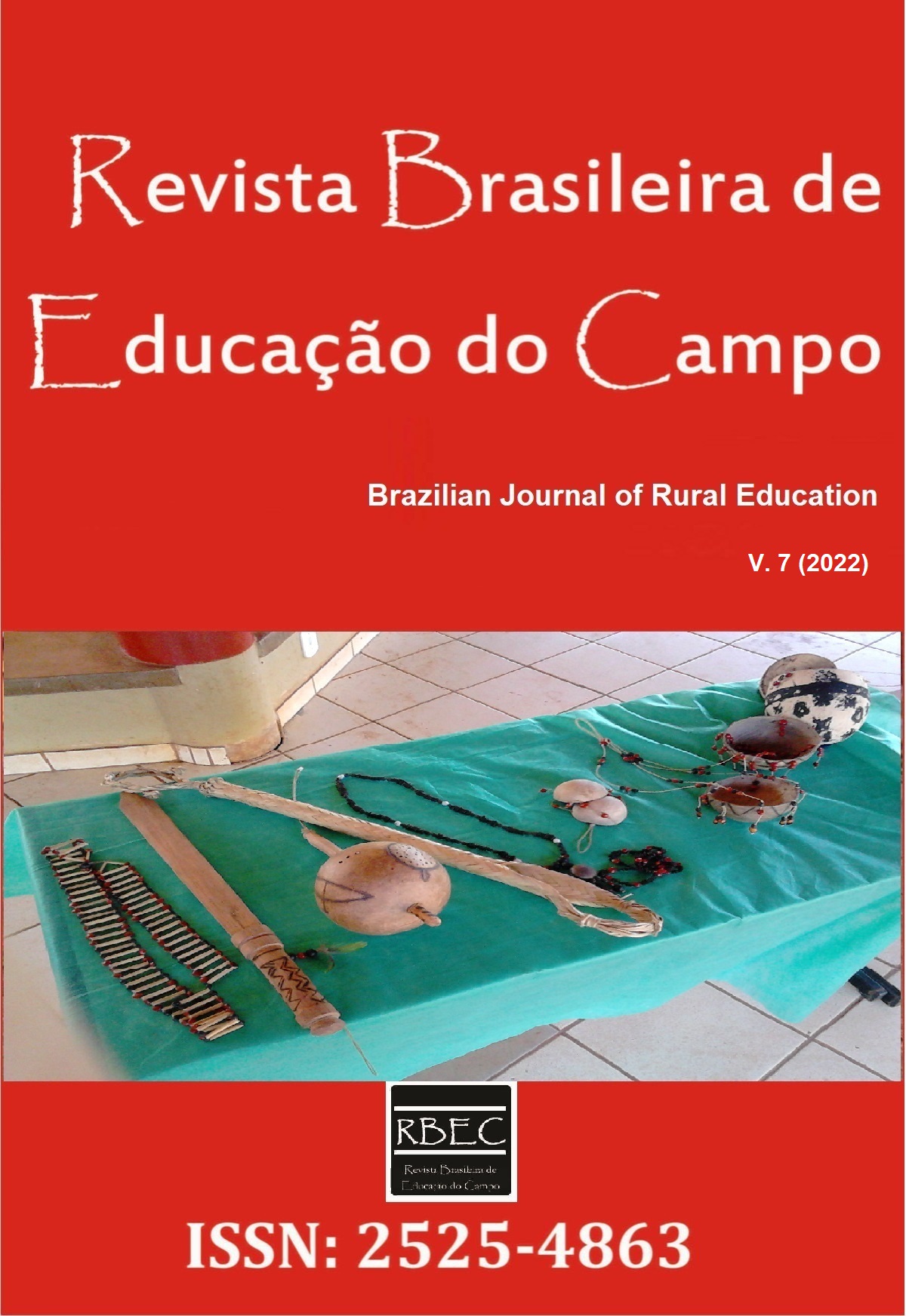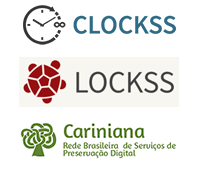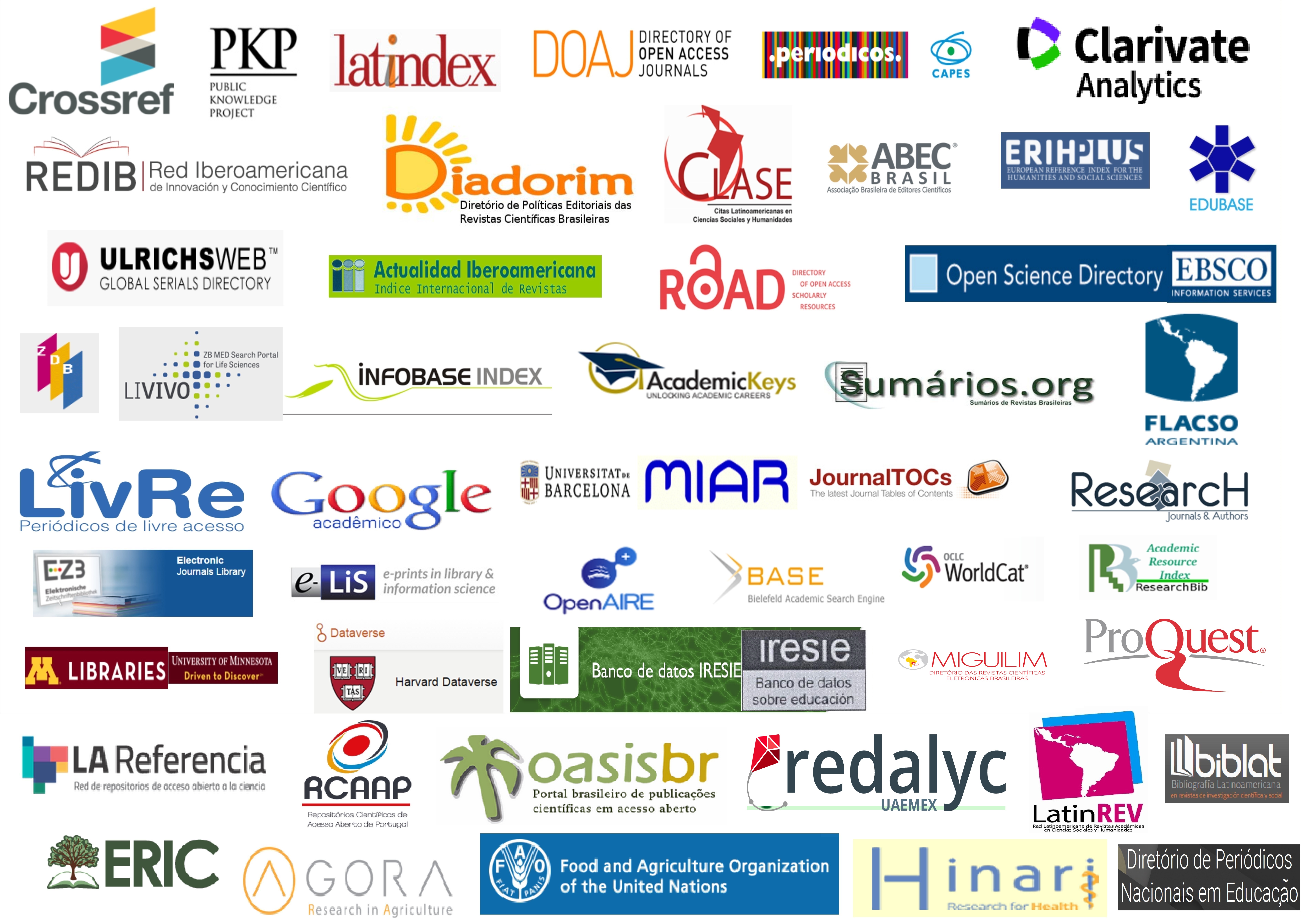Communication barriers in emergency remote education
DOI:
https://doi.org/10.20873/uft.rbec.e14210Palavras-chave:
aprendizaje pandémico, interacción educative, barreras de comunicaciónResumo
Barreiras de comunicação no ensino remoto emergencial
Apesar da abundância de métodos pedagógicos, materiais e filosofias, e de uma variedade de programas de formação de professores, muitos educadores ainda carecem de habilidades e autoeficácia necessárias para navegar efetivamente nas novas combinações educacionais de ensino a distância, semipresencial e presencial. Uma revisão da literatura sinaliza a natureza perturbada da comunicação professor-aluno. Este artigo aborda uma revisão de literatura focada nas descobertas de 206 artigos publicados em periódicos de acesso aberto sobre a interação educacional professor-aluno durante a pandemia. O objetivo principal da pesquisa atual é fornecer uma indicação inicial do tamanho potencial e da natureza das barreiras de comunicação existentes no aprendizado remoto de emergência. Além disso, os autores tentam tirar conclusões gerais sobre os méritos das proposições ou métodos existentes destinados a superar as barreiras existentes. As reclamações relatadas nas pesquisas incluem barreiras técnicas, psicológicas, pessoais, emocionais, problemas de saúde, falta de feedback, baixo engajamento dos alunos. Este último leva à busca de boas práticas que solucionem as barreiras de interação professor-aluno delineadas, ou reduzir o alcance dessas barreiras. Os achados deste estudo podem oferecer uma contribuição teórica para a compreensão dos diferentes tipos de barreiras nas interações professor-aluno no ensino a distância emergencial.
Palavras-chave: Covid-19, ensino remoto de emergência, aprendizagem pandêmica, interação educacional, interação professor-aluno.
Communication barriers in emergency remote education
ABSTRACT. Despite the abundance of methods, materials, pedagogical philosophies, and a variety of teacher training programs, many educators still do not have the skills and self-efficacy to effectively navigate the new combinations of distance, blended, and in-classroom learning. The review of literature signals the disrupted nature of teacher-student communication caused by the coronavirus pandemic. This is a literature review focused on the findings of 206 published open-access journal articles on teacher-student educational interaction during the COVID-19 pandemic. The primary goal of the current research is to provide an initial indication of the potential size and nature of the extant communication barriers in emergency remote learning. Furthermore, authors attempt to draw overall conclusions about the merits of existing propositions or methods aimed at overcoming the existing barriers. The complaints reported in the surveys include technical, psychological, personal, emotional, and health issues, lack of feedback, and poor student engagement. The latter prompts us to search for good practices that solve the aforementioned teacher-student interaction barriers or reduce the scope of these barriers. The outcomes of this study can help theorize about the many forms of barriers that exist in teacher-student interactions in emergency remote learning.
Keywords: Covid-19, emergency remote teaching, pandemic learning, educational interaction, teacher-student interaction.
Barreras de comunicación en la educación a distancia de emergencia
RESUMEN. A pesar de la abundancia de métodos, materiales y filosofías pedagógicas, una variedad de programas de formación de profesores, muchos educadores aún no tienen las habilidades requeridas para navegar efectivamente en los nuevos espacios educativos. Sin embargo, una revisión de la literatura señala la naturaleza interrumpida de la comunicación entre docentes y alumnus, causada por la pandemia del coronavirus (COVID-19). Esta es una revisión de la literatura centrada en los hallazgos de 206 artículos publicados en revistas de acceso abierto sobre la interacción educativa entre maestros y estudiantes durante la pandemia de COVID-19. El objetivo principal de la investigación actual es proporcionar una indicación inicial del tamaño potencial y la naturaleza de las barreras de comunicación existentes en el aprendizaje remoto de emergencia. Además, los autores intentan sacar conclusiones generales sobre los méritos de las proposiciones o métodos existentes destinados a superar las barreras existentes. Las quejas reportadas en las encuestas incluyen técnicas, psicológico, personal, emocional, problemas de salud, falta de retroalimentación, poca participación de los estudiantes. Este último incita a buscar buenas prácticas que resuelvan las barreras de interacción profesor-alumno señaladas o reduzcan el alcance de estas barreras. Los hallazgos de este estudio pueden ofrecer una contribución teórica para comprender los diferentes tipos de barreras en las interacciones docente-alumno en el aprendizaje remoto de emergencia.
Palabras clave: Covid-19, enseñanza remota de emergencia, aprendizaje pandémico, interacción educativa, interacción maestro-alumno.
Downloads
Referências
Abou Khalil, V., Helou, S., Khalife, E., Chen, M., Majumdar, R., & Ogata, H. (2021). Emergency Online Learning in Low-Resource Settings: Effective Student Engagement Strategies. Education Sciences, 11, 24. https://doi.org/10.3390/educsci11010024
Agung, A. S. N., Surtikanti, M. W., & Quinones, C. A. (2020). Students’ perception of online learning during COVID-19 pandemic: A case study on the English students of STKIP Pamane Talino. Soshum: Journal of Social Sciences and Humanities, 10(2), 225–235. https://doi.org/10.31940/soshum.v10i2.1316
Ahammed, B., Jahan, N., Seddeque, A., Hossain, M., Shovo, T., Khan, B., & Islam, N. (2021). Exploring the association between mental health and subjective sleep quality during the COVID-19 pandemic among Bangladeshi university students. Heliyon, e07082. https://doi.org/10.1016/j.heliyon.2021.e07082.
Akour. A., al-Tammemi, A’B., Barakat, M., Kanj, R., Fakhouri, H. N., Malkawi, A., & et al. (2020). The impact of the COVID-19 pandemic and emergency distance teaching on the psychological status of university teachers: a cross-sectional study in Jordan. American Journal of Tropical Medicine and Hygiene, 103(6), 2391–9. https://doi.org/10.4269/ajtmh.20-087
Anjum, S., Bhatti, R., & Iqbal, M. J. (2020). A Study of Communication Barriers in Open Distance Learning System of Education. Pakistan Journal of Distance and Online Learning, 6(1), 247-261
Antonovic, M. (2021). The wellbeing of Webster University students during Covid-19. https://doi.org/10.13140/RG.2.2.21477.32488
Atwa, H., Shehata, M., Al Ansari, A., Kumar, A., Jaradat, A., Ahmed, J., & Salem, A. H. (2021). Online, face-to-face, or blended learning? Faculty and medical students’ perception during the COVID-19 pandemic: A mixed-method study. Frontiers in Medicine, https://doi.org/10.21203/rs.3.rs-951471/v1
Bao, W. (2020). COVID-19 and online teaching in higher education: A case study of Peking University. Human Behavior and Emerging Technologies, 2(2), 113–115. https://doi.org/10.1002/hbe2.191
Berge, Z. (2013). Barriers to communication in distance education. Turkish Online Journal of Distance Education, 14, 374-388
Bertrand, L., Shaw, K. A., Ko, J., Deprez, D., Chilibeck, P. D., & Zello, G. A. (2021). The impact of the coronavirus disease 2019 (COVID-19) pandemic on university students’ dietary intake, physical activity, and sedentary behaviour. Applied Physiology, Nutrition, and Metabolism, 46(3), 265–272 https://doi.org/10.1139/apnm-2020-0990
Boon, B. (2015). Active Online Teaching Strategies – Sharing Best Practices. Retrieved from: https://www.researchgate.net/publication/272680707_Active_Online_Teaching_Strategies-Sharing_Best_Practices
Bozkurt, A., & Sharma, R. (2020). Emergency remote teaching in a time of global crisis due to CoronaVirus pandemic. Asian Journal of Distance Education, 15, 1-6. https://doi.org/10.5281/zenodo.3778083
Cao, W., Fang, Z., Hou, G., Han, M., Xu, X., Dong, J., & et al. (2020). The psychological impact of the COVID-19 epidemic on college students in China. PsychiatryRes, 287, 112934. https://doi.org/10.1016/j.psychres.2020.112934
Casacchia, M., Cifone, M. G.,, Giusti, L., Fabiani, L., Gatto, R., Lancia, L., Cinque, B., Petrucci, C., Giannoni, M., Ippoliti, R., Frattaroli, A., Macchiarelli, G., & Roncone, R. (2021). Distance education during COVID 19: an Italian survey on the university teachers’ perspectives and their emotional conditions. BMC Medical Education, 21. https://doi.org/10.1186/s12909-021-02780-y
Chaitra, S., Shruthi, K., Pushpa, G., & Chaitra, D. (2021). Study of stress in medical student during COVID pandemic. Indian Journal of Clinical Anatomy and Physiology, 8, 7-10. https://doi.org/10.18231/j.ijcap.2021.002
Frohn, J. (2021). Troubled schools in troubled times: How COVID-19 affects educational inequalities and what measures can be taken. European Educational Research Journal, 20(5), 667–683. https://doi.org/10.1177/14749041211020974
Gan, I., & Sun, R. (2022). Digital Barriers and Individual Coping Behaviors in Distance Education During COVID-19. International Journal of Knowledge Management, 18, 1–15. https://doi.org/10.4018/IJKM.290023
Georgoulias, P., Angelidis, G., Valotassiou, V., & Tsougos, I. (2021). COVID-19 crisis: Will on-line learning have negative consequences to our students? Cardiology in the Young, 31, 1-3. https://doi.org/10.1017/S104795112000493X
Kakepoto, I., Talpur, Q., Memon, I., Halepoto, I., & Bux Jalbani, K. (2021). Pedagogical Shift: Faculty Insights about E-Teaching Barriers during COVID Pandemic. International Journal of Innovation, Creativity and Change, 15(6), 1147-1160
Kilinc, H. (2021). Challenges Experienced in Distance Education and Solution Suggestions During the COVID-19 Pandemic Period. Handbook of Research on Managing and Designing Online Courses in Synchronous and Asynchronous Environments. Chapter: 21. Publisher: IGI Global. https://doi.org/10.4018/978-1-7998-8701-0.ch021
La Torre, G., Esposito, A., Sciarra, I., & Chiappetta, M. (2019). Definition, symptoms and risk of techno-stress: a systematic review. International Archives of Occupational and Environmental Health, 92(1), 13–35. https://doi.org/10.1007/s00420-018-1352-1
Lynch, M. (2020). E-learning during a global pandemic. Asian Journal of Distance Education, 15(1), 189-195. https://doi.org/10.1177/1540796916683710
MacIntyre, P. D., Gregersen, T., & Mercer, S. (2020). Language teachers’ coping strategies during the Covid-19 conversion to online teaching: Correlations with stress, wellbeing and negative emotions. System, 94. https://doi.org/10.1016/j.system.2020.102352
Main, A., Zhou, Q., Ma, Y., Luecken, L. J., & Liu, X. (2011). Relations of SARS-related stressors and coping to Chinese college students’ psychological adjustment during the 2003 Beijing SARS epidemic. Journal of Counseling Psychology, 58(3), 410–423. https://doi.org/10.1037/a0023632
Mićić, K., Kovács-Cerović, T., & Vračar, S. (2021). Trends in primary school teachers' experience over the first year of the COVID-19 pandemic in Serbia: A narrative analysis. Psiholoska istrazivanja, 24, 163–182. https://doi.org/10.5937/PSISTRA24-32799
Mikušková, E., & Verešová, M. (2020). Distance Education During COVID-19: the Perspective of Slovak Teachers. Problems of Education in the 21st Century, 78, 884–906. https://doi.org/10.33225/pec/20.78.884
Nabolsi, M., Abu-Moghli, F., Khalaf, I., Zumot, A., & Suliman, W. (2021). Nursing Faculty Experience with Online Distance Education During COVID-19 Crisis: A Qualitative Study. Journal of Professional Nursing, 37(5), 828–835, https://doi.org/10.1016/j.profnurs.2021.06.002
Ozüdoğru, G. (2021). Problems faced in distance education during Covid-19 Pandemic. Participatory Educational Research, 8, 321–333. https://doi.org/10.17275/per.21.92.8.4
Savage, M. J., James, R., Magistro, D., Donaldson, J., Healy, L. C., Nevill, M., & Hennis, P. J. (2020). Mental health and movement behaviour during the COVID-19 pandemic in UK university students: prospective cohort study. Mental Health and Physical Activity, 19, 100357. https://doi.org/10.1016/j.mhpa.2020.100357
Sterczewska, A., Wojtyniak, A., & Mrukwa-Kominek, E. (2022). Ocular Complaints from Students during COVID-19 Pandemic. Advances in Clinical and Experimental Medicine: Official Organ Wroclaw Medical University. Advance online publication. Retrieved from: https://doi.org/10.17219/acem/144199
UNESCO Institute for Statistics Data. (2020). COVID-19 impact on education. Retrieved from: https://en.unesco.org/covid19
Wang, C., Pan, R., Wan, X., Tan, Y., Xu, L., Ho, C. S., & Ho, R. C. (2020). Immediate Psychological Responses and Associated Factors during the Initial Stage of the 2019 Coronavirus Disease (COVID-19) Epidemic among the General Population in China. International Journal of Environmental Research and Public Health, 17(5), 1729. https://doi.org/10.3390/ijerph17051729
Whittle, C., Tiwari, S., Yan, S., & Williams, J. (2020). Emergency Remote Teaching Environment: A Conceptual Framework for Responsive Online Teaching in Crises. Information and Learning Sciences, 121(5), 311–319. https://doi.org/10.1108/ILS-04-2020-0099/full/html
Williams, T., McIntosh, R., & Russell, W. (2021). Equity in Distance Education During COVID-19. Research in Social Sciences and Technology, 6, 1–24. https://doi.org/10.46303/ressat.2021.1
Workneh, T. W., & Lin, M. C. (2021). Teaching Global Communication During COVID-19: Challenges, Mitigation, and Lessons Learned. Journalism & Mass Communication Educator, 76(4), 489–502. https://doi.org/10.1177/10776958211026176
Yang, L. H. (2021). Online learning experiences of Irish university students during the COVID-19 pandemic. All Ireland Journal of Higher Education, 13(1).
Zagkos, C., Kyridis, A., Kamarianos, I., Dragouni, Κ. E., Katsanou, A., Kouroumichaki, E., Papastergiou, N., & Stergianopoulos, E. (2022). Emergency Remote Teaching and Learning in Greek Universities During the COVID-19 Pandemic: The Attitudes of University Students. European Journal of Interactive Multimedia and Education, 3(1), e02207. https://doi.org/10.30935/ejimed/11494
Downloads
Como Citar
Edição
Seção
Licença
Proposta de Aviso de Direito Autoral Creative Commons
1. Proposta de Política para Periódicos de Acesso Livre
Autores que publicam nesta revista concordam com os seguintes termos:
a. Autores mantém os direitos autorais e concedem à revista o direito de primeira publicação, com o trabalho simultaneamente licenciado sob a Licença Creative Commons Attribution que permite o compartilhamento do trabalho com reconhecimento da autoria e publicação inicial nesta revista.
b. Autores têm autorização para assumir contratos adicionais separadamente, para distribuição não-exclusiva da versão do trabalho publicada nesta revista (ex.: publicar em repositório institucional ou como capítulo de livro), com reconhecimento de autoria e publicação inicial nesta revista.
c. Autores têm permissão e são estimulados a publicar e distribuir seu trabalho online (ex.: em repositórios institucionais ou na sua página pessoal) a qualquer ponto antes ou durante o processo editorial, já que isso pode gerar alterações produtivas, bem como aumentar o impacto e a citação do trabalho publicado (Veja O Efeito do Acesso Livre).
Proposal for Copyright Notice Creative Commons
1. Policy Proposal to Open Access Journals
Authors who publish with this journal agree to the following terms:
A. Authors retain copyright and grant the journal right of first publication with the work simultaneously licensed under the Creative Commons Attribution License that allows sharing the work with recognition of its initial publication in this journal.
B. Authors are able to take on additional contracts separately, non-exclusive distribution of the version of the paper published in this journal (ex .: publish in institutional repository or as a book), with an acknowledgment of its initial publication in this journal.
C. Authors are permitted and encouraged to post their work online (eg .: in institutional repositories or on their website) at any point before or during the editorial process, as it can lead to productive exchanges, as well as increase the impact and the citation of published work (See the Effect of Open Access).














